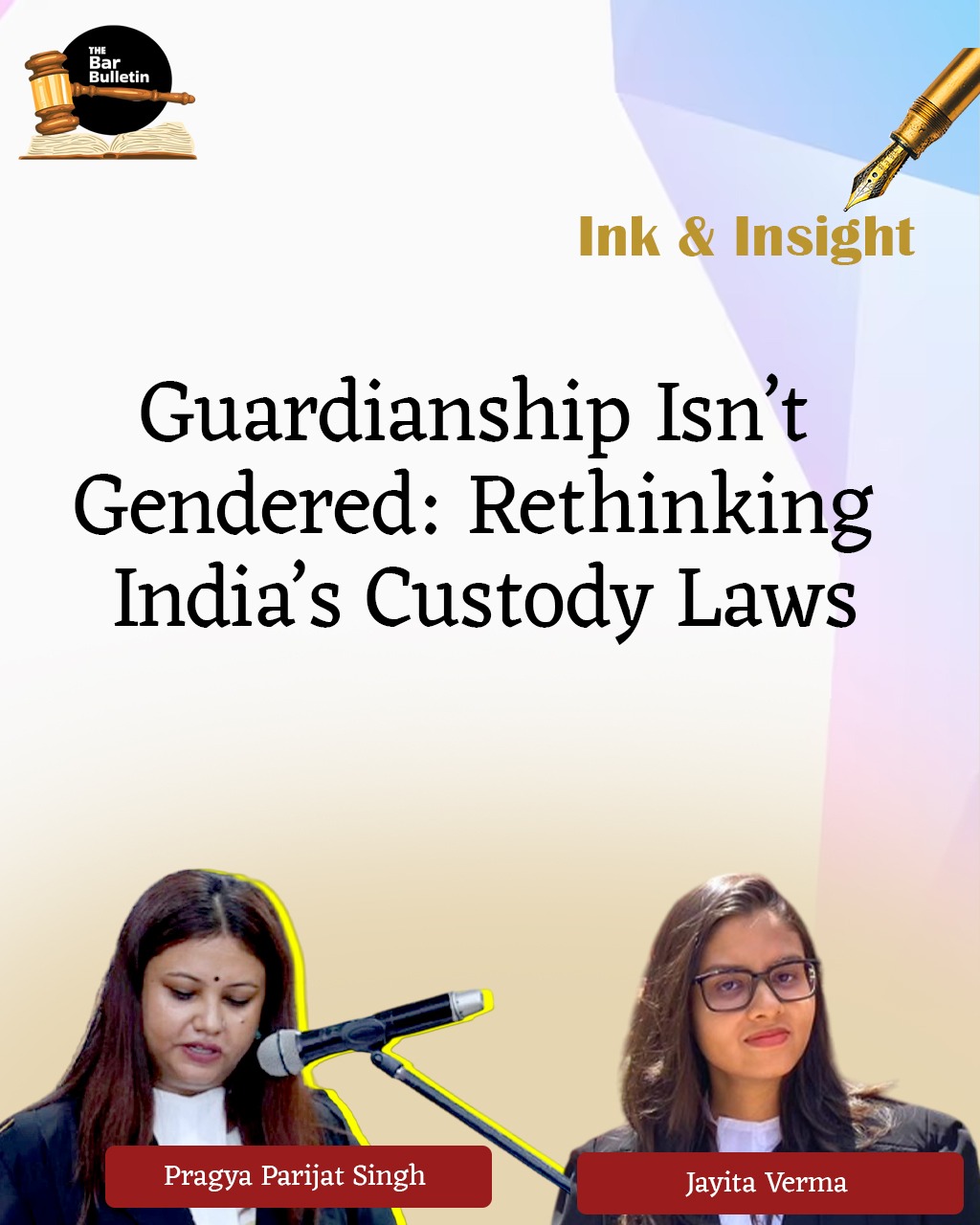The Allahabad High Court while hearing a custody petition titled as Saumya Sajiv Kumar Sharma v. State of U.P[1] pointed out the archaic and obsolete provisions of the Guardian and Wards Act,1890 and said that the law should reflect evolution from patriarchal views and move towards gender neutrality. The Court emphasized that legislative reform is urgently needed so that laws reflect evolving social norms and operate on a gender-neutral basis. It praised judicial interpretation for filling this void so far, especially in granting mothers preferential custody of daughters, but insisted that progressive norms must be codified consistently across India
Child custody battles, especially those arising from marital discord, are one of the most emotionally and legally complex issues in Indian family law, yet the legal framework governing such matters, primarily the Guardian and Wards Act, 1890 and personal law statutes, remains tethered to archaic notions of parental roles, and gender stereotypes. With the Constitution guaranteeing equality (Articles 14, 15 and 21) and the judiciary increasingly acknowledging the evolving nature of family structures and gender roles, it is imperative that our guardianship laws reflect a gender-neutral, child-centric approach. As society moves toward more egalitarian family roles, and the courts repeatedly assert the “welfare of the child” as paramount, the need for comprehensive, gender-neutral legislative reform is both urgent and constitutionally mandated.
Custody and Guardianship: Distinct but Interlinked
Guardianship refers to the legal authority to make decisions on behalf of a minor, including matters relating to their person and property. Custody, on the other hand, specifically pertains to the care and day-to-day upbringing of the child, including with whom the child resides. Custody could be both permanent and visitational. While guardianship implies legal control, custody involves practical care. Indian laws do not explicitly define “custody”, and the legal structure often blurs the line between custody and guardianship, leading to confusion and inconsistent outcomes in courts. Despite their differences, both the laws should be guided by the principles of the child’s welfare.
Notably, Section 6(a) of the HMGA privileges the father over the mother as the natural guardian of a minor. Although in the landmark case Githa Hariharan v. Reserve Bank of India[2], dealt with gender equality in guardianship laws under the Hindu Minority and Guardianship Act, 1956, particularly challenging the interpretation of Section 6(a) which made the father the natural guardian “and after him” the mother. The Supreme Court, in this case, interpreted “after him” not to mean “after the lifetime of the father,” but rather “in the absence of the father’s proper care,” thereby bringing parity between the rights of father and mother as natural guardians.
Similarly, in ABC v. State (NCT of Delhi)[3] , the Court allowed an unwed Christian mother to become the sole guardian of her child without disclosing the father’s identity.
In, Shazia Aman Khan vs State of Orissa[4],the Court clarified that while statutory guardianship rights may reside with a biological parent (as per Section 19 of the Guardians and Wards Act), custody decisions belong to the child’s welfare, and courts may order custody in favor of caregivers irrespective of gender or blood relation—based on stability and child preference
However, these judgments remain exceptions rather than rules. The core legal provisions have not been amended, leaving wide judicial discretion and scope for patriarchal interpretations in lower courts. A codified recognition of equal parental guardianship is still lacking in the Indian legal landscape.
Child First : The International Framework and India’s Global Commitments
India is a signatory to the United Nations Convention on the Rights of the Child (UNCRC), which emphasizes the “best interests of the child” as a primary consideration in all decisions affecting them (Article 3), and recognizes the equal responsibilities of both parents (Article 18)l. The traditional approach to custody in India has centered around sole custody, usually to the mother with limited visitation rights to the father. However, psychological research and global practices suggest that shared parenting models where both parents participate equally in a child’s life are more conducive to a child’s development. Other countries like Australia, the UK, and the Netherlands have codified shared custody frameworks. In India, though statutory provisions remain silent on shared custody, some High Courts have embraced the concept. In KM Vinaya v. B. Srinivas[5], joint custody was granted by dividing the year equally between both parents, marking a notable shift toward institutionalizing shared parentage. Yet, ground reality in Indian context is such that the Indian domestic law continues to perpetuate a parent-centric rather than child-centric model to date. Although Indian laws aim to protect the welfare of the child, there is currently no specific legislation that addresses the concept of joint custody or shared parenting. Over the years, there has been growing advocacy for reforms to incorporate a shared parenting framework into Indian family law, similar to the legal provisions found in many other countries.
Legal void : Gendered battle for child custody
The Law Commission of India, in its 257th Report released in 2015, emphasized the need to treat both parents as equal guardians in matters concerning children. It proposed amendments to the Guardian and Wards Act, 1890 and personal law statutes and further observed that children should not be treated as property subject to exclusive ownership by one parent. It advocated moving beyond the traditional sole custody model and instead recommended the adoption of a balanced approach through shared parenting. To facilitate this, the Commission proposed a detailed draft framework promoting joint responsibility and involvement of both parents in the child’s upbringing, even after separation or divorce. Yet, legislative action remains pending. This inherently gendered hierarchy continues to inform judicial discretion, even though courts increasingly profess to consider the “welfare of the child” as paramount. The persistence of statutory language that prioritizes paternal authority undermines the constitutional guarantee of gender equality and fails to accommodate contemporary family dynamics such as single mothers, stay-at-home fathers, and co-parenting arrangements.
Way forward
Need of the hour is the recognition of both parents as natural guardians irrespective of gender or marital status and the same must be enshrined in statute books. The law must acknowledge diverse caregiving roles and enable courts to assess custody based on parenting ability, emotional bond, and logistical feasibility rather than gendered assumptions. Further, the “welfare of the child” must be given a concrete, multidimensional meaning, taking into account psychological well-being, continuity in education, emotional support systems, and the child’s own preferences particularly in cases involving older minors. Reform must also contemplate and codify frameworks for shared or joint custody. In an era of rising divorce rates, adversarial custodial models often result in the child becoming a pawn in litigation. Shared parenting arrangements can mitigate this and encourage cooperation between parents and considering the problem related to monetary responsibility, a pro-rata model of expenditure, where each parent contributes in proportion to their income, ensuring that financial responsibility is shared equitably rather than equally can be followed. Since the welfare of the child is central to the very institution of marriage, it must remain a priority even after its breakdown. While sole custody may be suitable in specific cases, wherever possible, maintaining the bond with both parents supports the child’s emotional and developmental well-being. Lastly, the legal recognition of custodial rights must extend to non-marital and non-traditional families including unwed mothers, single fathers, adoptive parents, and LGBTQ+ caregivers in a manner that puts the child’s welfare first, rather than social conformity.
In, Deepika Singh v. Central Administrative Tribunal[6] the Supreme Court broadened the legal concept of “family” to include single-parent families, queer partnerships, live-in relationships, and atypical family structures. It recognized that these families are entitled to the same statutory and constitutional protections as traditional families, reinforcing gender-neutral equality.
Despite the clear benefits of shared parenting, the absence of specific legislation in India creates grey areas in its implementation, highlighting the urgent need for legal reform. Therefore, a future-ready legal framework must treat both parents as equal partners in the upbringing of a child and make the child’s welfare not parental gender, status, or religion the axis around which custody decisions revolve. A uniform, gender-neutral, and child-focused guardianship law is not merely desirable ,it is a constitutional imperative. It is time for Parliament to act decisively and give India a guardianship regime that is gender-just, norm-sensitive, and child-focused.
*Pragya Parijat Singh– Advocate on Record
**Jayita Verma- Advocate
[1] 2025:AHC:93203
[2] (1999) 2 SCC 228
[3] (2015) 10 SCC 1
[4] (2024) 7 SCC 564
[5] 2013 SCC OnLine Kar 8269
[6] 2021 SCC OnLine SC 3534

